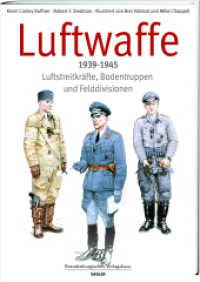- ホーム
- > 洋書
- > 英文書
- > History / World
基本説明
Explores the spiritual, emotional and physical effects of the enclosed shopping mall on the public, chronicling the growth of the mall as a popular development model, its role in shaping urban and suburban life in the US, its positive and negative aspects on society and its future viability.
Full Description
Since the construction of the first fully enclosed shopping center in 1952, the shopping mall has evolved into the heart of many suburban areas across the United States. More than simply a place to purchase goods, this veritable "temple of consumerism" has become a primary place for community and social interaction and an essential element in many citizens' day-to-day lives.
This study explores the spiritual, emotional and physical effects of the enclosed shopping mall on the public, chronicling the growth of the mall, its role in shaping urban and suburban life, its positive and negative impacts on society and the environment, and its future viability. As this work shows, the mall remains rich in symbolic influence, and in many ways mirrors the American condition.
Contents
Table of Contents
Introduction
1. The Birth of the Mall
2. Suburbia and the American Dream
3. The Decline of Downtown
4. The Mall and Religion
5. Main Street
6. Teens and the Mall
7. Senior Citizens and the Mall
8. The Mall as "Public" Space
9. The Mall and the Environment
10. Dawn of the Dead Mall
11. The Rise of the Big Boxes
12. Regional Mall Case Studies
13. Case Studies: Super-Regional Malls, Lifestyle Centers, and Hybrids
14. New Urbanism and the Death of the Urban Mall
15. The Future of Public Space in America
Notes
Bibliography
Index








